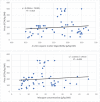Livestock feed resources in the West African Sahel
- PMID: 35910094
- PMCID: PMC9303701
- DOI: 10.1002/agj2.20955
Livestock feed resources in the West African Sahel
Abstract
Limited supply of quality feed is the most important factor limiting livestock productivity in many sub-Saharan African (SSA) countries. Having a systematic inventory of available feed resources, identifying main challenges and potentials for improvement is the first step towards designing development strategies to improve feed quality and quantity. The objective of this study was to review the available feed resources and their quality in West African Sahel across different agro-ecological zones and to identify the research gaps and strategies to improve feed resource availability. The West African Sahelian zone is home to 135 million people who herd 173 million head of ruminant livestock. The main feed resources for grazing ruminants are pastures and crop residues; commercially formulated feeds are increasingly being used in poultry and pig production, particularly in peri-urban areas. Feed resources for livestock are diverse and vary markedly across agro-ecological zones in the West African Sahel and across seasons in terms of type, quantity, and quality. Given that crop residues are among the most important feed resources, there is need to invest in promoting adoption of proven methods for improving their quality and preserving it. Given poorly developed feed markets in the Sahelian rural areas and cities, strengthening the feed value chain is critical for improving the feed resource base in West Africa. Additional critically important needs are to increase awareness about the importance of feed quality, to create quality-based feed marketing systems, and to appreciate and enhance women's roles in feed production.
© 2021 The Authors. Agronomy Journal published by Wiley Periodicals LLC on behalf of American Society of Agronomy.
Conflict of interest statement
The authors declare that there is no conflict of interest.
Figures






References
-
- Abdoulaye, S. G. , & Ly, C. (2014). Crop residues and agro‐industrial byproducts in West Africa Situation and way forward for livestock production . Food and Agriculture Organization Regional Office for Africa Accra Food and Agriculture Organization of The United Nations.
-
- Abdulrazak, S. A. , Fujihara, T. , Ondiek, J. K. , & Ørskov, E. R. (2000). Nutritive evaluation of some Acacia tree leaves from Kenya. Animal Feed Science and Technology, 85, 89–98 10.1016/S0377-8401(00)00133-4 - DOI
-
- Adebowale, E. A. (1988). An overview of recent trends and developments in the use of unconventional feed ingredients for ruminant animals: applicability to the Nigerian conditions. In E. A. Adebowale (Ed.), Proceedings of National Workshop on Alternative Formulations of Livestock Feeds in Nigeria, organized by the Economic Affairs Office, The Presidency, ARMTI, Ilorin, 21–25 November 1988 (pp. 544–578). Food and Agricultural Organization.
-
- Agyemang, K. (2012). Crop‐based agriculture and livestock integration: Conception principles and practice in Sub‐Saharan Africa. In H. K. Dei, F. K. Avornyo, & N. Karbo (Eds.), Proceeding of regional workshop on sustainable intensification of crop‐livestock systems in Ghana for increased farm productivity and food/nutrition security, Tamale, Ghana, 27–28 Aug. 2012.
-
- Aduku, A. O. (2004). Animal nutrition in the tropics feeds and feeding, pastures management, monogastric and ruminant nutrition. Davicom.
LinkOut - more resources
Full Text Sources
Research Materials
